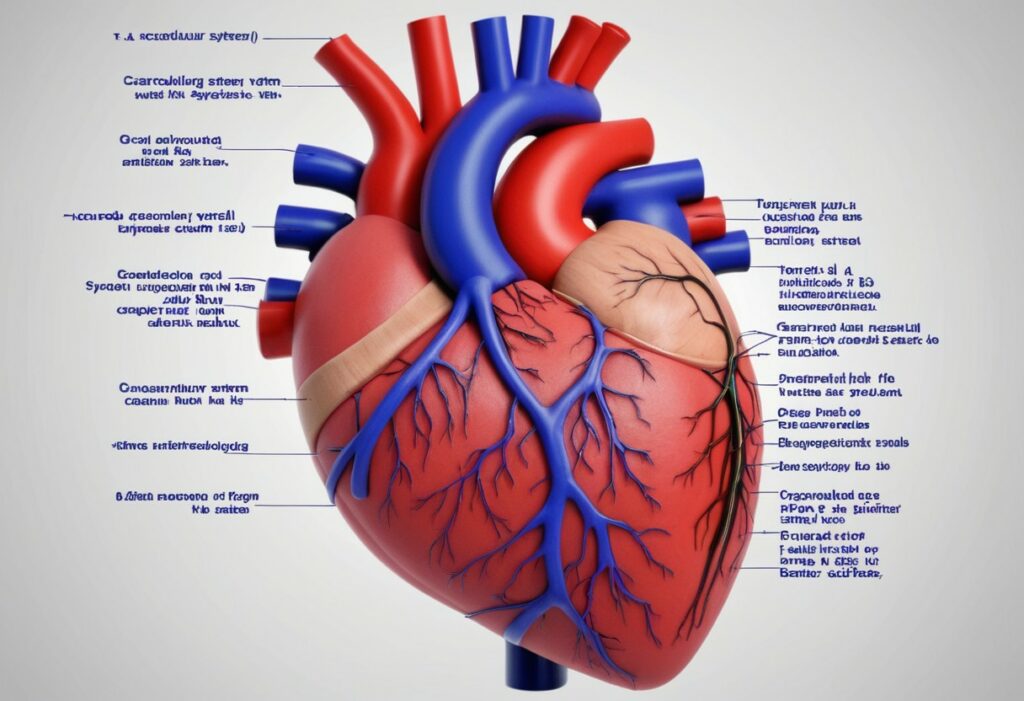The cardiovascular system, also called the circulatory system, is crucial for human life. It acts as the body’s transportation system, moving oxygen, nutrients, hormones, and waste products to and from cells, tissues, and organs. This system is essential for keeping the body’s internal environment stable even when things change outside. From the heartbeat to how blood travels through the body’s tubes (arteries, veins, and capillaries), the cardiovascular system manages many important processes needed for life.
Understanding the structure, function, and importance of the cardiovascular system is essential for knowing its vital role in our health. It includes the heart, blood vessels, and blood, all working together to support the body’s needs and keep it working well. The heart, a strong muscle in the chest, pumps blood throughout the body. Blood vessels create a vast network to carry blood everywhere, making sure cells get what they need and waste gets removed.
Realizing how important the cardiovascular system is highlights the need to keep it healthy. Things like regular exercise, eating well, and managing stress are vital for supporting heart health and lowering the chances of heart-related problems. By understanding how the cardiovascular system works, people can make smart choices to stay healthy and live longer.
Anatomy of the Cardiovascular System
The cardiovascular system, also known as the circulatory system, is a complex network of organs and vessels that move important substances around the body. It includes the heart, blood vessels, and blood, all working together to deliver oxygen, nutrients, hormones, and remove waste from cells. Knowing how this system is structured helps us understand how it works.
The Heart
In the center of the cardiovascular system is the heart, a strong muscle about the size of a clenched fist in the chest. It has four chambers: two atria (atrium singular) and two ventricles. The right atrium gets blood without oxygen from the body, while the left atrium gets oxygenated blood from the lungs. The atria squeeze to push blood into the ventricles, which then push blood out of the heart.
The right ventricle pumps blood without oxygen to the lungs through the pulmonary artery, where it picks up oxygen. The oxygen-rich blood goes back to the left atrium and then to the left ventricle, which pumps it to the body through the aorta, the biggest artery. This cycle, called the cardiac cycle, keeps blood moving around the body.
Blood Vessels
Blood vessels form a complex system that carries blood to and from the heart, delivering oxygen and nutrients and removing waste. Arteries carry oxygen-rich blood away from the heart, while veins bring back oxygen-poor blood. Capillaries, tiny vessels, help exchange gases, nutrients, and waste between blood and tissues.
Arteries are strong vessels that handle the heart’s strong pumping. They split into smaller arterioles, then capillaries. Capillaries are very thin, allowing only one red blood cell to pass at a time, which helps with efficient exchange of gases and nutrients. Veins bring blood back to the heart, getting bigger as they go towards it. They have valves to stop blood from going backward, which is crucial, especially in the legs where blood fights gravity to return to the heart. Veins join into the superior and inferior vena cavae, which take blood without oxygen back to the right atrium.
Blood
Blood is a special fluid made of cells floating in a liquid called plasma. It carries oxygen, nutrients, hormones, and waste around the body. Blood has three main types of cells: red blood cells carry oxygen, white blood cells help fight infections, and platelets help blood clot.
Plasma, the liquid part of blood, is clear and carries nutrients, hormones, and waste. It also helps with immune defense and clotting. Plasma is mostly water, with dissolved ions, proteins, fats, and other important stuff for keeping the body balanced.
Understanding how the cardiovascular system is structured and works helps us see how it keeps the body running smoothly. It’s crucial for staying healthy and alive.
Function of the Cardiovascular System
The cardiovascular system, also known as the circulatory system, is a complex network of organs and vessels that move important substances around the body. Its main job is to carry oxygen and nutrients to cells and take away waste, helping all parts of the body work well. This article explains how the cardiovascular system works, from the heart pumping to blood moving through the body.
Heart Pumping
The heart is at the center of the cardiovascular system. It’s a strong muscle with four parts: two atria and two ventricles. The right atrium gets blood without oxygen from the body, while the left atrium gets oxygen-rich blood from the lungs. The atria squeeze to push blood into the ventricles, which then push blood out of the heart.
The right ventricle sends blood without oxygen to the lungs through the pulmonary artery. There, it picks up oxygen. The oxygen-rich blood goes back to the left atrium and then to the left ventricle, which sends it to the body through the aorta, the biggest artery. This cycle, called the cardiac cycle, keeps blood moving around the body.
Blood Moving Around
Once oxygen-rich blood leaves the left ventricle, it goes into the body’s tissues and organs. Arteries carry it away from the heart, getting smaller until they become capillaries. Capillaries are very small vessels that let gases, nutrients, and waste move between blood and tissues.
Oxygen and nutrients go from the capillaries into the tissues, feeding cells. Waste like carbon dioxide goes from the tissues into the capillaries to be taken away. Blood without oxygen, now with waste, goes back to the heart through venules and veins.
Blood Flow to Lungs
After going through the body and giving oxygen to tissues, blood without oxygen goes back to the heart. It goes into the right atrium, then to the right ventricle, and to the lungs through the pulmonary artery. In the lungs, carbon dioxide is traded for oxygen, making the blood rich in oxygen again. This oxygen-rich blood goes back to the left atrium through the pulmonary veins, finishing the loop.
Blood Vessels
Blood vessels make a big network that helps blood move around the body. Arteries carry oxygen-rich blood away from the heart, becoming smaller arterioles that control blood flow to tissues. Capillaries let gases, nutrients, and waste move between blood and tissues.
Veins bring blood without oxygen back to the heart, getting bigger as they go towards it. They have valves that stop blood from going back. This is important, especially in the legs where blood fights gravity to go back to the heart. Veins join into the superior and inferior vena cavae, which take blood without oxygen back to the right atrium.
Blood Flow Control
The cardiovascular system controls blood flow to match what the body needs. It does this in different ways, like autoregulation, neural regulation, and hormonal regulation. Autoregulation lets tissues change blood flow based on how much they need. Neural regulation uses the autonomic nervous system to control heart rate and blood vessel size. Hormonal regulation uses hormones like adrenaline and noradrenaline to increase heart rate and blood pressure in response to stress or exercise.
The cardiovascular system is essential for keeping the body balanced and alive by moving oxygen and nutrients to cells and taking waste away. From the heart pumping to blood moving through arteries, veins, and capillaries, every part of it works together to move important things around the body. Understanding how it works is crucial for knowing how to stay healthy and well.
Importance of the Cardiovascular System
The cardiovascular system, often called the body’s lifeline, is crucial for keeping us healthy and full of energy. It’s made up of the heart, blood vessels, and blood, all working together to do many important jobs that keep us alive and well. This article explains why the cardiovascular system is so important, focusing on its main functions and what happens if things go wrong.
Regulating Blood Pressure
One big job of the cardiovascular system is to control blood pressure, which is how hard blood pushes against the walls of blood vessels. Blood pressure needs to be just right to make sure all parts of the body get enough oxygen and nutrients. The heart pumps blood into arteries, and these arteries help control blood pressure. The body uses a mix of nerves, hormones, and local tricks to keep blood pressure in check, making sure the heart and blood vessels aren’t strained.
Balancing Electrolytes
The cardiovascular system also helps balance electrolytes, like sodium, potassium, calcium, and magnesium. These are charged particles that help nerves work, muscles contract, and fluids stay balanced. The kidneys, with help from the cardiovascular system, manage electrolytes by deciding how much to keep and how much to get rid of. If electrolytes get out of balance, it can mess up heart rhythms, weaken muscles, and cause other big health problems.
Controlling Temperature
The cardiovascular system helps control body temperature by moving heat around the body. When we’re active or hot, more blood goes to the skin, letting heat escape. In cold weather, less blood goes to the skin to keep heat in and keep us warm. This helps stop us from getting too hot or too cold, keeping our bodies working well.
Supporting the Immune System
Our cardiovascular system also helps our immune system by carrying immune cells, antibodies, and other immune parts to places where the body needs them. White blood cells travel through the blood to fight infections or heal injuries. Antibodies travel in the blood to fight off germs and clear infections.
Helping with Healing
The cardiovascular system helps heal wounds by carrying oxygen, nutrients, and growth factors to injured areas. Blood vessels help immune cells and other helpers get to the injured spot, where they clean up and help build new tissue. Good blood flow is crucial for healing well, and problems with blood flow can slow healing and cause long-term damage.
Problems with the Cardiovascular System
Issues with the cardiovascular system can cause big problems and make life hard. Conditions like high blood pressure, heart disease, heart failure, irregular heartbeats, and poor circulation are common. They can lead to heart attacks, strokes, kidney problems, and more if not treated. Preventing problems, catching them early, and managing them well are key to staying healthy.
The cardiovascular system is a complex and vital network that brings oxygen and nutrients to cells all over the body. Its jobs, like controlling blood pressure, balancing electrolytes, managing temperature, supporting the immune system, and helping heal wounds, keep us alive and feeling good. But if something goes wrong with the cardiovascular system, it can cause serious issues. By living healthy, exercising, eating well, and getting help when needed, we can keep our cardiovascular system strong and lower the risk of problems.
After researching credible sources on the web, my aim in writing health-related articles is to provide a basic idea about the anatomy of organs in our body and related health issues. Always consult your physician or another qualified healthcare provider if you have any questions about a medical condition or treatment plans.










More Stories
Inside the Hormonal Symphony: Understanding the Endocrine System
Understanding Gallstones: Causes, Symptoms, and Treatment Options
Cells: The Foundation of Life